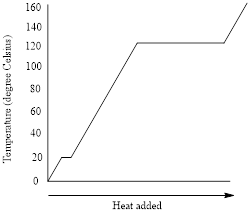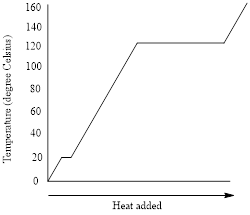
(a)
Interpretation: The freezing point of the liquid has to be given.
Concept Introduction: Heating curves represents the change in temperature as a substance is heated. Cooling curves represents the change in temperature as a substance is cooled. Heating and cooling curves have horizontal flat parts that show the phase changes.
(a)
Answer to Problem 12STP
The freezing point of the liquid is
Explanation of Solution
The given heating-cooling curve is,

Figure 1: Heating-cooling curve of the liquid
The heating curve (addition of energy) goes from left to right in the above graph and the cooling curve (removal of energy) goes from right to left.
The flat portions of the curve represent the changes in phases and the slope of the curve represents the changes in temperature.
For the freezing point of a liquid, the cooling curve is considered. The freezing point is the temperature at which liquid turns into solid. The freezing point of the liquid in the given heating-cooling curve is
(b)
Interpretation: The boiling point of the liquid has to be given.
Concept Introduction: Heating curves represents the change in temperature as a substance is heated. Cooling curves represents the change in temperature as a substance is cooled. Heating and cooling curves have horizontal flat parts that show the phase changes.
(b)
Answer to Problem 12STP
Explanation of Solution
The given heating-cooling curve is,

Figure 1: Heating-cooling curve of the liquid
The heating curve (addition of energy) goes from left to right in the above graph and the cooling curve (removal of energy) goes from right to left.
The flat portions of the curve represent the changes in phases and the slope of the curve represents the changes in temperature.
For the boiling point of the liquid, the heating curve is considered. The boiling point is the temperature at which liquid changes to vapor phase by the addition of heat. The boiling point of the liquid in the given heating-cooling curve is
(c)
Interpretation: The property (heat of fusion or heat vaporization) that is greater has to be given and the reason has to be explained.
Concept Introduction:
The heat of fusion is the energy that is needed to melt one mole of solid to liquid at a constant temperature.
The heat of vaporization is the energy that is needed to convert one mole of liquid to a gas at a constant temperature.
(c)
Answer to Problem 12STP
The heat of vaporization is greater because the energy needed to convert the molecules from liquid to gas is much greater than that of the energy needed to convert the molecules from solid to liquid.
Explanation of Solution
The heat of fusion is the energy that is needed to melt one mole of solid to liquid at a constant temperature.
The heat of vaporization is the energy that is needed to convert one mole of liquid to a gas at a constant temperature.
In solids, the molecules are closely packed and they have a strong intermolecular force of attraction. The strong intermolecular forces cause the substance to have a structure in which the molecule has little freedom to move.
In liquids, the molecules are closely packed but less than that of solid. They have more freedom and the intermolecular forces are weaker than that of solid.
In gases, the molecules are far apart from each other and they have the weakest intermolecular forces.
When a solid is heated into a liquid, the kinetic energy of its molecules increases, move them further apart until the intermolecular forces are decreased to allow it to flow freely.
When a liquid is heated into vapor, the kinetic energy of the molecules is increased to a point where there is no intermolecular force of attraction between the molecules.
The heat of vaporization is greater because the energy needed to convert the molecules from liquid to gas is much greater than that of the energy needed to convert the molecules from solid to liquid.
Chapter 14 Solutions
World of Chemistry, 3rd edition
- 8. (16 pts) Provide the stepwise mechanism for the synthesis of the following compound via an enaminearrow_forwardDraw the titration curve of (i) weak acid vs. strong base; (ii) weak acid vs. weakbase; (iii) diprotic acid with strong base (iii) triprotic acid with strong base.arrow_forwardComplete the reaction in the drawing area below by adding the major products to the right-hand side. If there won't be any products, because nothing will happen under these reaction conditions, check the box under the drawing area instead. Note: if the products contain one or more pairs of enantiomers, don't worry about drawing each enantiomer with dash and wedge bonds. Just draw one molecule to represent each pair of enantiomers, using line bonds at the chiral center. More... No reaction. my ㄖˋ + 1. Na O Me Click and drag to start drawing a structure. 2. H +arrow_forward
- Predict the intermediate 1 and final product 2 of this organic reaction: NaOMe H+ + 1 2 H H work up You can draw 1 and 2 in any arrangement you like. Note: if either 1 or 2 consists of a pair of enantiomers, just draw one structure using line bonds instead of 3D (dash and wedge) bonds at the chiral center. Click and drag to start drawing a structure. X $ dmarrow_forwardPredict the major products of this organic reaction: 1. NaH (20°C) 2. CH3Br ? Some notes: • Draw only the major product, or products. You can draw them in any arrangement you like. • Be sure to use wedge and dash bonds where necessary, for example to distinguish between major products that are enantiomers. • If there are no products, just check the box under the drawing area. No reaction. Click and drag to start drawing a structure. G Crarrow_forwardPredict the major products of this organic reaction: 1. LDA (-78°C) ? 2. Br Some notes: • Draw only the major product, or products. You can draw them in any arrangement you like. . • Be sure to use wedge and dash bonds where necessary, for example to distinguish between major products that are enantiomers. • If there are no products, just check the box under the drawing area. No reaction. Click and drag to start drawing a structure. Xarrow_forward
- Please draw the structuresarrow_forwardDraw the missing intermediates 1 and 2, plus the final product 3, of this synthesis: 0 1. Eto 1. Eto- 1 2 2. MeBr 2. EtBr H3O+ A 3 You can draw the three structures in any arrangement you like. Explanation Check Click and drag to start drawing a structure.arrow_forwardDraw the missing intermediate 1 and final product 2 of this synthesis: 1. MeO- H3O+ 1 2 2. PrBr Δ You can draw the two structures in any arrangement you like. Click and drag to start drawing a structure.arrow_forward
- What is the differences between: Glyceride and phosphoglyceride Wax and Fat Soap and Fatty acid HDL and LDL cholesterol Phospho lipids and sphingosine What are the types of lipids? What are the main lipid components of membrane structures? How could lipids play important rules as signaling molecules and building units? The structure variety of lipids makes them to play significant rules in our body, conclude breifly on this statement.arrow_forwardWhat is the differences between DNA and RNA for the following: - structure - function - type What is the meaning of: - replication - transcription - translation show the base pair connection(hydrogen bond) in DNA and RNAarrow_forwardWhat is the IP for a amino acid- give an example what are the types of amino acids What are the structures of proteins The N-Terminal analysis by the Edman method shows saralasin contains sarcosine at the N-terminus. Partial hydrolysis of saralasin with dilute hydrochloric acid yields the following fragments: Try-Val-His Sar-Arg-Val His-Pro-Ala Val- Tyr- Val Arg-Val-Tyr What is the structure of saralasin?arrow_forward
 ChemistryChemistryISBN:9781305957404Author:Steven S. Zumdahl, Susan A. Zumdahl, Donald J. DeCostePublisher:Cengage Learning
ChemistryChemistryISBN:9781305957404Author:Steven S. Zumdahl, Susan A. Zumdahl, Donald J. DeCostePublisher:Cengage Learning ChemistryChemistryISBN:9781259911156Author:Raymond Chang Dr., Jason Overby ProfessorPublisher:McGraw-Hill Education
ChemistryChemistryISBN:9781259911156Author:Raymond Chang Dr., Jason Overby ProfessorPublisher:McGraw-Hill Education Principles of Instrumental AnalysisChemistryISBN:9781305577213Author:Douglas A. Skoog, F. James Holler, Stanley R. CrouchPublisher:Cengage Learning
Principles of Instrumental AnalysisChemistryISBN:9781305577213Author:Douglas A. Skoog, F. James Holler, Stanley R. CrouchPublisher:Cengage Learning Organic ChemistryChemistryISBN:9780078021558Author:Janice Gorzynski Smith Dr.Publisher:McGraw-Hill Education
Organic ChemistryChemistryISBN:9780078021558Author:Janice Gorzynski Smith Dr.Publisher:McGraw-Hill Education Chemistry: Principles and ReactionsChemistryISBN:9781305079373Author:William L. Masterton, Cecile N. HurleyPublisher:Cengage Learning
Chemistry: Principles and ReactionsChemistryISBN:9781305079373Author:William L. Masterton, Cecile N. HurleyPublisher:Cengage Learning Elementary Principles of Chemical Processes, Bind...ChemistryISBN:9781118431221Author:Richard M. Felder, Ronald W. Rousseau, Lisa G. BullardPublisher:WILEY
Elementary Principles of Chemical Processes, Bind...ChemistryISBN:9781118431221Author:Richard M. Felder, Ronald W. Rousseau, Lisa G. BullardPublisher:WILEY





